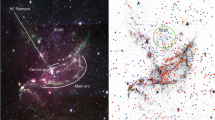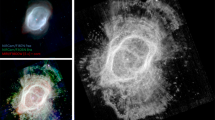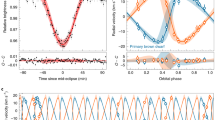Abstract
The Kuiper belt is a collection of small bodies (Kuiper belt objects, KBOs) that lie beyond the orbit of Neptune and which are believed to have formed contemporaneously with the planets. Their small size and great distance make them difficult to study. KBO 55636 (2002 TX300) is a member of the water-ice-rich Haumea KBO collisional family1. The Haumea family are among the most highly reflective objects in the Solar System. Dynamical calculations indicate that the collision that created KBO 55636 occurred at least 1 Gyr ago2,3. Here we report observations of a multi-chord stellar occultation by KBO 55636, which occurred on 9 October 2009 ut. We find that it has a mean radius of 143 ± 5 km (assuming a circular solution). Allowing for possible elliptical shapes, we find a geometric albedo of  in the V photometric band, which establishes that KBO 55636 is smaller than previously thought and that, like its parent body, it is highly reflective. The dynamical age implies either that KBO 55636 has an active resurfacing mechanism, or that fresh water-ice in the outer Solar System can persist for gigayear timescales.
in the V photometric band, which establishes that KBO 55636 is smaller than previously thought and that, like its parent body, it is highly reflective. The dynamical age implies either that KBO 55636 has an active resurfacing mechanism, or that fresh water-ice in the outer Solar System can persist for gigayear timescales.
This is a preview of subscription content, access via your institution
Access options
Subscribe to this journal
Receive 51 print issues and online access
$199.00 per year
only $3.90 per issue
Buy this article
- Purchase on Springer Link
- Instant access to full article PDF
Prices may be subject to local taxes which are calculated during checkout


Similar content being viewed by others
References
Brown, M. E., Barkume, K. M., Ragozzine, D. & Schaller, E. L. A collisional family of icy objects in the Kuiper belt. Nature 446, 294–296 (2007)
Ragozzine, D. & Brown, M. E. Candidate members and age estimate of the family of Kuiper belt object 2003 EL61. Astron. J. 134, 2160–2167 (2007)
Schlichting, H. E. & Sari, R. The creation of Haumea's collisional family. Astrophys. J. 700, 1242–1246 (2009)
Elliot, J. L. & Kern, S. D. Pluto's atmosphere and a targeted-occultation search for other bound KBO atmospheres. Earth Moon Planets 92, 375–393 (2003)
Reitsema, H. J., Hubbard, W. B., Lebofsky, L. A. & Tholen, D. J. Occultation by a possible third satellite of Neptune. Science 215, 289–291 (1982)
Zuluaga, C. A., Bosh, A. S., Person, M. J. & Elliot, J. L. 55636.20091009 Occultation October 09, 2009. 〈http://occult.mit.edu/research/occultations/kbo/55636/55636.20091009/index.html〉 (2009)
Nather, R. E. & Evans, D. S. Photoelectric measurement of lunar occultations. I. The process. Astron. J. 75, 575–582 (1970)
Brucker, M. J. et al. High albedos of low inclination classical Kuiper belt objects. Icarus 201, 284–294 (2009)
Bowell, E. et al. in Asteroids II (eds Binzel, R. P., Gehrels, T. & Matthews, M. S.) 524–556 (Univ. Arizona Press, 1989)
Sheppard, S. S. & Jewitt, D. Hawaii Kuiper belt variability project: an update. Earth Moon Planets 92, 207–219 (2003)
Grundy, W., Noll, K. & Stephens, D. Diverse albedos of small trans-neptunian objects. Icarus 176, 184–191 (2005)
Stansberry, J. A. et al. in The Solar System beyond Neptune (eds Barucci, M. A., Boehnhardt, H., Cruikshank, D. P. & Morbidelli, A.) 161–179 (Univ. Arizona Press, 2008)
Licandro, J. et al. The methane ice rich surface of large TNO 2005 FY9: a Pluto-twin in the trans-neptunian belt? Astron. Astrophys. 445, L35–L38 (2006)
Snodgrass, C., Carry, B., Dumas, C. & Hainaut, O. Characteristics of candidate members of (136108) Haumea's family. Astron. Astrophys. 511, 1–9 (2010)
Gil-Hutton, R. Color diversity among Kuiper belt objects: the collisional resurfacing model revisited. Planet. Space Sci. 50, 57–62 (2002)
Luu, J. & Jewitt, D. Color diversity among the Centaurs and Kuiper Belt objects. Astron. J. 112, 2310–2318 (1996)
Verbiscer, A. J., French, R. G. & McGhee, C. A. The opposition surge of Enceladus: HST observations 338–1022 nm. Icarus 173, 66–83 (2005)
Spencer, J. R. et al. in Saturn from Cassini-Huygens (eds Dougherty, M., Esposito, L. W. & Krimigis, S.) 683–724 (Springer, 2009)
Rabinowitz, D. L., Schaefer, B. E., Schaefer, M. & Tourtellotte, S. W. The youthful appearance of the 2003 EL61 collisional family. Astron. J. 136, 1502–1509 (2008)
Hobbs, P. V. Ice Physics 1st edn 348 (Oxford Univ. Press, 1974)
Spencer, J. R., Lebofsky, L. A. & Sykes, M. V. Systematic biases in radiometric diameter determinations. Icarus 78, 337–354 (1989)
Brown, M. E. in The Solar System beyond Neptune (eds Barucci, M. A., Boehnhardt, H., Cruikshank, D. P. & Morbidelli, A.) 335–344 (Univ. Arizona Press, 2008)
Gulbis, A. A. S. et al. Charon's radius and atmospheric constraints from observations of a stellar occultation. Nature 439, 48–51 (2006)
French, R. G. & Gierasch, P. J. Diffraction calculation of occultation light curves in the presence of an isothermal atmosphere. Astron. J. 81, 445–451 (1976)
Rabinowitz, D. L. et al. Photometric observations constraining the size, shape, and albedo of 2003 EL61, a rapidly rotating, Pluto-sized object in the Kuiper Belt. Astrophys. J. 639, 1238–1251 (2006)
Brown, M. E. et al. Satellites of the largest Kuiper belt objects. Astrophys. J. 639, L43–L46 (2006)
Ragozzine, D. & Brown, M. E. Orbits and masses of the satellites of the dwarf planet Haumea (2003 EL61). Astron. J. 137, 4766–4776 (2009)
Fraser, W. C. & Brown, M. E. NICMOS photometry of the unusual dwarf planet Haumea and its satellites. Astrophys. J. 695, L1–L3 (2009)
Schaller, E. L. & Brown, M. E. Detection of additional members of the 2003 EL61 collisional family via near-infrared spectroscopy. Astrophys. J. 684, L107–L109 (2008)
Astrodon:. Astrodon astronomy filters. 〈http://www.astrodon.com/products/filters/〉 (2008)
Acknowledgements
We are grateful to W. M. Grundy for supplying HV magnitudes from his database and for discussions of water-ice surfaces in the outer Solar System; to W. B. McKinnon for discussions of the physical state of water-ice at low temperatures; to E. D. Schmidt for use of the telescope and participating in the observations at Behlen Observatory; to B. Carter for help in obtaining telescope time at Mt Kent, and to L. A. Young for assisting with the McDonald observations. We thank D. Byrne of the Visitor Information Station at the Onizuka Center for International Astronomy on Mauna Kea for use of their equipment and facilitating the observations from their site. J.W. thanks E. Gates of Lick Observatory, and E. Becklin, E. Pfueller, M. Wiedemann and M. Burgdort of SOFIA, for support of his observations. B. Sicardy provided several comments that improved the paper. Occultation research at MIT and Williams College is supported by NASA and NSF.
Author information
Authors and Affiliations
Contributions
J.L.E. helped plan the observations, consulted on the occultation prediction, analysed the data, and wrote the paper. M.J.P. organized the observers, performed observations from Brownsville, Texas, and consulted on the prediction, data reduction, text and figures. C.A.Z. analysed the data for the stellar occultation prediction and constructed the light curves. A.S.B. directed the data analysis for the occultation prediction. E.R.A. wrote the light-curve generation software. S.E.L. made astrometric observations and performed observations of the occultation from the USNO in Flagstaff. M.L. designed and built 12 PICO camera systems and attempted observations from Cairns. J.M.P. arranged for observations at several sites and helped to plan the observations. S.P.S. consulted on the design of the PICO. L.B., E.W.D., S.S.S. and T.T. supplied astrometric data for the occultation prediction. D.R. provided information used to derive the geometric albedo of KBO 55636. Authors identified in Supplementary Table 2 were responsible for the observations. All authors were given the opportunity to review the results and comment on the manuscript.
Corresponding author
Ethics declarations
Competing interests
The authors declare no competing financial interests.
Supplementary information
Supplementary Information
This file contains Supplementary Information and Data, Supplementary Tables 1-5, Supplementary Figures 1-3 with legends and References. (PDF 1244 kb)
PowerPoint slides
Rights and permissions
About this article
Cite this article
Elliot, J., Person, M., Zuluaga, C. et al. Size and albedo of Kuiper belt object 55636 from a stellar occultation. Nature 465, 897–900 (2010). https://doi.org/10.1038/nature09109
Received:
Accepted:
Issue Date:
DOI: https://doi.org/10.1038/nature09109
This article is cited by
-
The formation of Haumea and its family via binary merging
Nature Communications (2022)
-
A dearth of small members in the Haumea family revealed by OSSOS
Nature Astronomy (2019)
-
A ring system detected around the Centaur (10199) Chariklo
Nature (2014)
-
Albedo and atmospheric constraints of dwarf planet Makemake from a stellar occultation
Nature (2012)
-
Eris under scrutiny
Nature (2011)
Comments
By submitting a comment you agree to abide by our Terms and Community Guidelines. If you find something abusive or that does not comply with our terms or guidelines please flag it as inappropriate.



